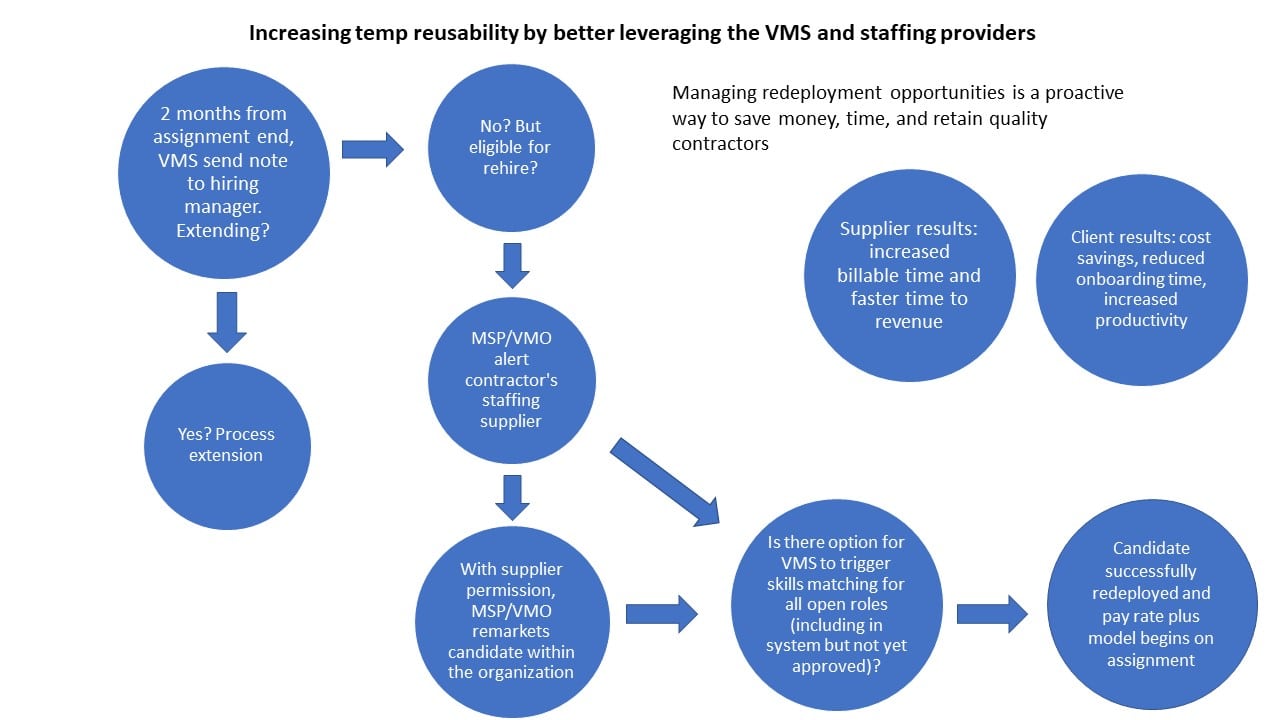 Talent provides a competitive edge for most enterprises, but it can also be a significant driver of cost. Cost control is always top of mind for executives, and with most experts estimating that contingent workers make up almost 40% of the total workforce in the US, this population may be the key to both gaining that competitive edge and unlocking an organization’s cost savings. While there are many ways this can be accomplished, one trend that is emerging is a self-sourcing model of engaging contractors.
Talent provides a competitive edge for most enterprises, but it can also be a significant driver of cost. Cost control is always top of mind for executives, and with most experts estimating that contingent workers make up almost 40% of the total workforce in the US, this population may be the key to both gaining that competitive edge and unlocking an organization’s cost savings. While there are many ways this can be accomplished, one trend that is emerging is a self-sourcing model of engaging contractors.
The rise of this on-demand talent, sourced outside of the traditional staffing firm model, uniquely allows enterprises to engage and source talent directly, typically through private or public talent pools. And while this sourcing model is considerably cheaper than paying staffing firm margins, it is not a silver bullet and likely only going to apply to a small percentage of your total talent needs. A key principle of private talent pools is that enterprises can benefit from staying connected to known talent (e.g., retirees, alumni, former interns) who can be contacted for potential contract opportunities in the future for just a little more than traditional payroll rates.
It’s not to say the self-sourcing model is irrelevant or doesn’t merit cost savings on its own, but what are companies doing to hold on to already known non-employee contractors or consultants to redeploy them proactively within the organization before they leave?
And while proponents of self-sourcing often tout that former employees and retirees are what make up these private talent pools, talent that originally came from a staffing firm is likely to be proactively redeployed to assignments at another customer. All of that internal knowledge, training and investment has been lost.
PREMIUM CONTENT: Direct Sourcing Platform Landscape
The redeployment of contract labor is arguably a much more powerful lever when it comes to benefiting from the proven quality of known resources while also gaining efficiencies in the onboarding process and cutting costs in training, management and possibly agency fees. There is also a key diversity and inclusion aspect that we cannot ignore. Rebecca Perrault, VP of diversity, equity and inclusion at Magnit, highlights this importance. “We are working hard with our clients to develop diverse contingent talent in their organizations, investing in the development of inclusion knowledge and enabling their success. When we lose highly skilled talent at the end of their contracts, we are continually forced to start over. We need to do our best to redeploy our talent, both individuals from diverse demographic groups and all the talent we have developed, to contribute to the inclusive cultures our clients are creating.”
But understanding who is onboard, when assignments will actually finish and a contingent worker’s capabilities is often difficult — even if a company has technology or services to help bring headcount and spend to light. It can be challenging to consistently understand who and where they work (especially if they are on an SOW or are project-based workers), what projects are they working on, whether these projects being delivered on time and within budget, and whether targets are being met.
As perplexing can be determining whether an assignment is actually going to be completed on the original contract end date, with close to 65% of all assignments being extended — often a week or so before the assignment is set to terminate.
But there is tremendous worth, both from cost and value to the business, in the redeployment of resources who are already familiar with your organization — people who have a proven track record of success, require little to no onboarding or training, and can add immediate value.
In part two of this series, I will explore ways to drive redeployment as a core strategy.
